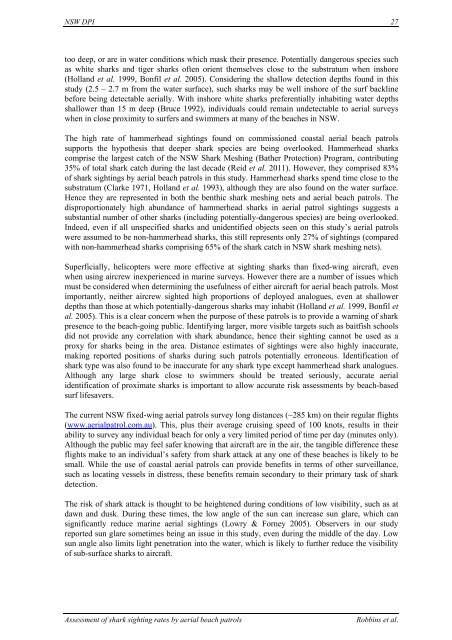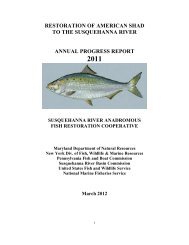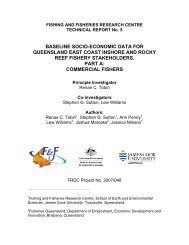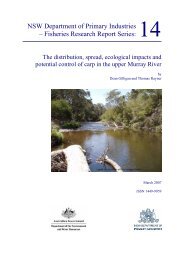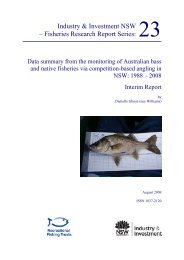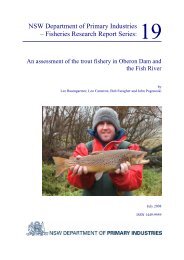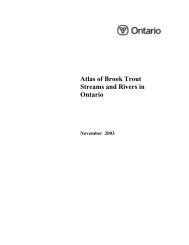Assessment of shark sighting rates by aerial ... - Fisheries Reports
Assessment of shark sighting rates by aerial ... - Fisheries Reports
Assessment of shark sighting rates by aerial ... - Fisheries Reports
Create successful ePaper yourself
Turn your PDF publications into a flip-book with our unique Google optimized e-Paper software.
NSW DPI 27<br />
too deep, or are in water conditions which mask their presence. Potentially dangerous species such<br />
as white <strong>shark</strong>s and tiger <strong>shark</strong>s <strong>of</strong>ten orient themselves close to the substratum when inshore<br />
(Holland et al. 1999, Bonfil et al. 2005). Considering the shallow detection depths found in this<br />
study (2.5 – 2.7 m from the water surface), such <strong>shark</strong>s may be well inshore <strong>of</strong> the surf backline<br />
before being detectable <strong>aerial</strong>ly. With inshore white <strong>shark</strong>s preferentially inhabiting water depths<br />
shallower than 15 m deep (Bruce 1992), individuals could remain undetectable to <strong>aerial</strong> surveys<br />
when in close proximity to surfers and swimmers at many <strong>of</strong> the beaches in NSW.<br />
The high rate <strong>of</strong> hammerhead <strong>sighting</strong>s found on commissioned coastal <strong>aerial</strong> beach patrols<br />
supports the hypothesis that deeper <strong>shark</strong> species are being overlooked. Hammerhead <strong>shark</strong>s<br />
comprise the largest catch <strong>of</strong> the NSW Shark Meshing (Bather Protection) Program, contributing<br />
35% <strong>of</strong> total <strong>shark</strong> catch during the last decade (Reid et al. 2011). However, they comprised 83%<br />
<strong>of</strong> <strong>shark</strong> <strong>sighting</strong>s <strong>by</strong> <strong>aerial</strong> beach patrols in this study. Hammerhead <strong>shark</strong>s spend time close to the<br />
substratum (Clarke 1971, Holland et al. 1993), although they are also found on the water surface.<br />
Hence they are represented in both the benthic <strong>shark</strong> meshing nets and <strong>aerial</strong> beach patrols. The<br />
disproportionately high abundance <strong>of</strong> hammerhead <strong>shark</strong>s in <strong>aerial</strong> patrol <strong>sighting</strong>s suggests a<br />
substantial number <strong>of</strong> other <strong>shark</strong>s (including potentially-dangerous species) are being overlooked.<br />
Indeed, even if all unspecified <strong>shark</strong>s and unidentified objects seen on this study’s <strong>aerial</strong> patrols<br />
were assumed to be non-hammerhead <strong>shark</strong>s, this still represents only 27% <strong>of</strong> <strong>sighting</strong>s (compared<br />
with non-hammerhead <strong>shark</strong>s comprising 65% <strong>of</strong> the <strong>shark</strong> catch in NSW <strong>shark</strong> meshing nets).<br />
Superficially, helicopters were more effective at <strong>sighting</strong> <strong>shark</strong>s than fixed-wing aircraft, even<br />
when using aircrew inexperienced in marine surveys. However there are a number <strong>of</strong> issues which<br />
must be considered when determining the usefulness <strong>of</strong> either aircraft for <strong>aerial</strong> beach patrols. Most<br />
importantly, neither aircrew sighted high proportions <strong>of</strong> deployed analogues, even at shallower<br />
depths than those at which potentially-dangerous <strong>shark</strong>s may inhabit (Holland et al. 1999, Bonfil et<br />
al. 2005). This is a clear concern when the purpose <strong>of</strong> these patrols is to provide a warning <strong>of</strong> <strong>shark</strong><br />
presence to the beach-going public. Identifying larger, more visible targets such as baitfish schools<br />
did not provide any correlation with <strong>shark</strong> abundance, hence their <strong>sighting</strong> cannot be used as a<br />
proxy for <strong>shark</strong>s being in the area. Distance estimates <strong>of</strong> <strong>sighting</strong>s were also highly inaccurate,<br />
making reported positions <strong>of</strong> <strong>shark</strong>s during such patrols potentially erroneous. Identification <strong>of</strong><br />
<strong>shark</strong> type was also found to be inaccurate for any <strong>shark</strong> type except hammerhead <strong>shark</strong> analogues.<br />
Although any large <strong>shark</strong> close to swimmers should be treated seriously, accurate <strong>aerial</strong><br />
identification <strong>of</strong> proximate <strong>shark</strong>s is important to allow accurate risk assessments <strong>by</strong> beach-based<br />
surf lifesavers.<br />
The current NSW fixed-wing <strong>aerial</strong> patrols survey long distances (~285 km) on their regular flights<br />
(www.<strong>aerial</strong>patrol.com.au). This, plus their average cruising speed <strong>of</strong> 100 knots, results in their<br />
ability to survey any individual beach for only a very limited period <strong>of</strong> time per day (minutes only).<br />
Although the public may feel safer knowing that aircraft are in the air, the tangible difference these<br />
flights make to an individual’s safety from <strong>shark</strong> attack at any one <strong>of</strong> these beaches is likely to be<br />
small. While the use <strong>of</strong> coastal <strong>aerial</strong> patrols can provide benefits in terms <strong>of</strong> other surveillance,<br />
such as locating vessels in distress, these benefits remain secondary to their primary task <strong>of</strong> <strong>shark</strong><br />
detection.<br />
The risk <strong>of</strong> <strong>shark</strong> attack is thought to be heightened during conditions <strong>of</strong> low visibility, such as at<br />
dawn and dusk. During these times, the low angle <strong>of</strong> the sun can increase sun glare, which can<br />
significantly reduce marine <strong>aerial</strong> <strong>sighting</strong>s (Lowry & Forney 2005). Observers in our study<br />
reported sun glare sometimes being an issue in this study, even during the middle <strong>of</strong> the day. Low<br />
sun angle also limits light penetration into the water, which is likely to further reduce the visibility<br />
<strong>of</strong> sub-surface <strong>shark</strong>s to aircraft.<br />
<strong>Assessment</strong> <strong>of</strong> <strong>shark</strong> <strong>sighting</strong> <strong>rates</strong> <strong>by</strong> <strong>aerial</strong> beach patrols Robbins et al.


